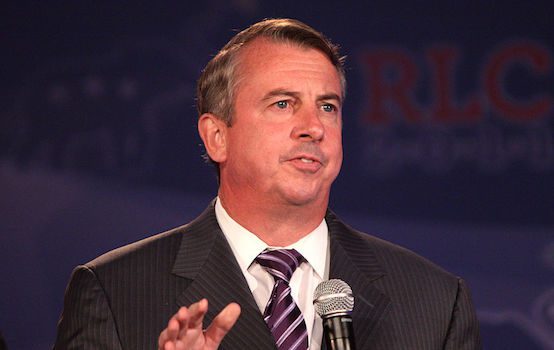That Bloodbath in Old Dominion

The day after his “Silent Majority” speech on Nov. 3, 1969, calling on Americans to stand with him for peace with honor in Vietnam, Richard Nixon’s GOP captured the governorships of Virginia and New Jersey.
By December, Nixon had reached 68 percent approval in the Gallup Poll, though, a year earlier, he had won but 43 percent of the vote.
Contrast Nixon’s numbers with President Trump’s.
Where Trump won 46 percent of the vote against Hillary Clinton, his approval rating is now nearly 10 points below that. He has less support today than on the day he was elected, or inaugurated.
Tens of millions of Americans are passionately for Trump, and tens of millions are passionately against him. The GOP problem: The latter cohort is equal in intensity but larger in number, and this is especially true in purple and blue states like the commonwealth of Virginia.
There is no way to spin Tuesday as other than a Little Bighorn, and possible harbinger of what is to come.
In George Washington’s hometown of Alexandria and Arlington County, Democratic candidate Ralph Northam won 4-1. In Fairfax and Loudoun counties, the most populous D.C. suburbs, Northam won 2-1.
Gillespie rolled up the landslides.
As there are two Americas, there are two Virginias.
Consider. Of all the delegate seats in the Virginia assembly allocated to Alexandria, Arlington, Fairfax, Loudoun and Prince William counties, the GOP can today claim only one.
Northern Virginia is taking on the political and socioeconomic profile of San Francisco.
Another and perhaps insoluble problem for the GOP, not only in the Old Dominion, is demography.
Democrats rolled up their largest margins among African-Americans, Hispanics, single women, immigrants and the young. And these voting blocs are growing.
Gillespie ran up his largest margins among white males near and past retirement age and married white women. These Middle Americans are in inexorable demographic decline.
The Greatest Generation is passing on, and baby boomers born between 1946 and 1951 are now on Medicare and Social Security.
Yet reports of the GOP’s demise are grossly exaggerated.
Though Gillespie lost by nine points, Jill Vogel, who ran for lieutenant governor on Trumpian issues, lost by six.
By 2-1, Virginians do not want their Confederate monuments torn down. Northam, sensing this, moved toward Gillespie’s position as the campaign went on. Also, among the 27 percent of Virginians who regarded taxes and immigration as the top issues, Gillespie won by nearly 4-1.
It was health care concerns, the No. 1 issue, that buried the GOP.
As for mainstream media rage and revulsion at the “racism” of Gillespie ads suggesting Northam supported sanctuary cities and was soft on the MS-13 gang, this reflects an abiding establishment fear of the Trumpian issues of illegal immigration and crime.
Then there was the Republican messenger.
A former chairman of the RNC, Washington lobbyist and White House aide, Gillespie is an establishment Republican unconvincing in the role of a fighting populist conservative. His speeches recalled not Trump’s run, but that of the Republicans Trump trounced.
Ed Gillespie was Virginia’s version of Jeb Bush.
Message from the Old Dominion: A purple state, trending blue, with its economy recession-proof as long as Uncle Sam across the river consumes 20 percent of GDP, is a steepening climb for the GOP. You must have a superior candidate, comfortable with cutting issues, to win it now.
Republicans are being admonished to drop the monuments-and-memorials issue and respect why NFL players might want to “take a knee” during the national anthem.
But if to win in Northern Virginia the GOP must move closer to the Democratic Party, why would the rest of the state want to vote for the Republican Party?
During the campaign, both candidates moved rightward.
Northam rejected sanctuary cities and accepted Lee and Jackson on Richmond’s Monument Avenue, and Gillespie ran Trumpian ads, even if they seemed to clash with the mild-mannered candidate himself.
The lesson for 2018:
While the solid support of Trumpians is indispensable for GOP victory, it is insufficient for GOP victory. Republican candidates will have to decide how close they wish to get to President Trump, or how far away they can risk going and survive.
Facing this choice, Sens. Jeff Flake and Bob Corker decided to pack it in. Other Republicans may follow. But a house divided will not stand.
Republicans should recall that off-year elections are often problematic for incumbent parties. In 1954, President Eisenhower lost both houses of Congress. After pardoning Nixon in 1974, Gerald Ford lost 49 seats. In 1982, Ronald Reagan sustained a 27-seat loss.
In 1994, Bill Clinton lost 53 seats and control of the House. In 2010, Barack Obama lost 63 seats and control of the House.
If the nation chooses to turn Congress over to Nancy Pelosi and Chuck Schumer in 2018, will that be all Trump’s fault? Or should perhaps some credit go to Paul Ryan, Mitch McConnell and venerable political tradition?
Patrick J. Buchanan is the author of a new book, Nixon’s White House Wars: The Battles That Made and Broke a President and Divided America Forever.
Comments